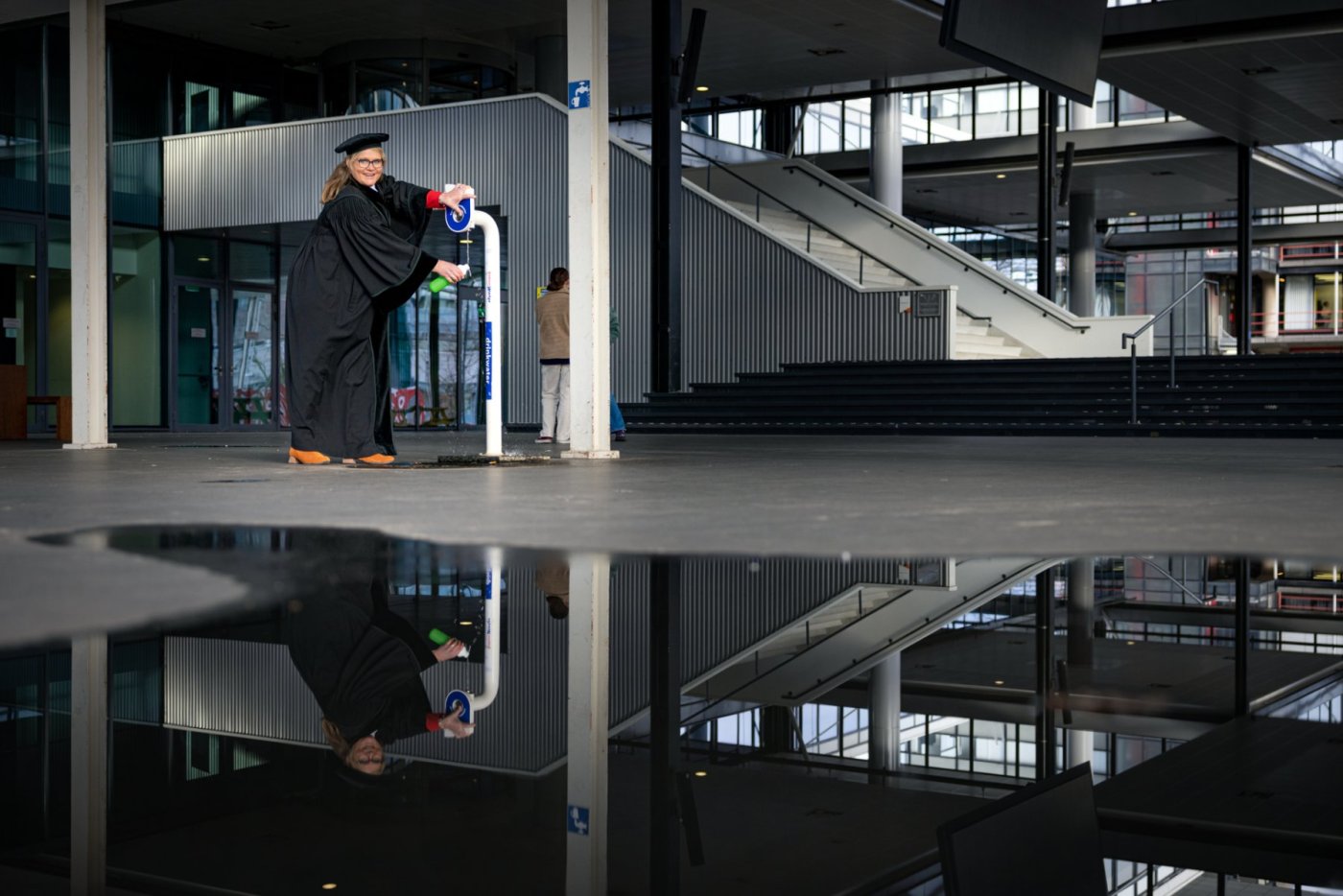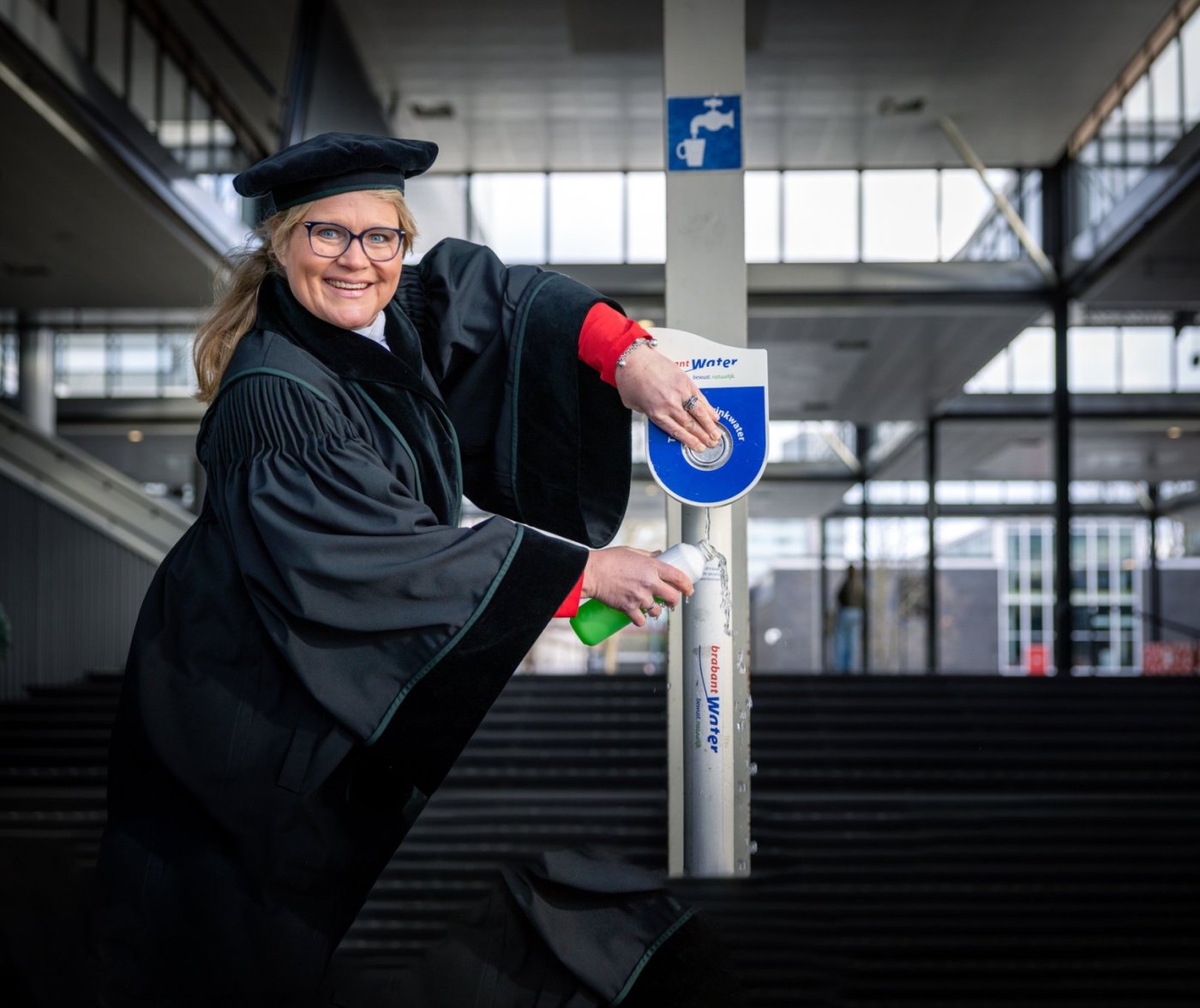As Kitty Nijmeijer knows well, realising a circular economy requires collaboration between science and industry and it takes place at the intersection of science and industry. Publicly funded research does not just generate knowledge that finds its way via industry to society in useful applications that lead to economic growth, which in turn provides more public funds. It also discovers very interesting questions for fundamental research in precisely those applications it provided the knowledge for. And that is certainly the case in her discipline, membrane materials and technology.
‘A mix of all the components influences what a membrane ultimately excretes and how effectively it does that’, Nijmeijer explains. Therefore, the complexity of many industrial feed streams delivers just as many questions for fundamental research as the opportunities for impact they provide. This means that research and valorisation are not only correlated with each other, but largely coincide and that universities, industry and society have a lot to gain by working together.
Cross-fertilisation
At Eindhoven University of Technology, Nijmeijer leads a multidisciplinary group that connects chemistry, materials science and process technology and that combines fundamental academic research with working with industry. In the group’s laboratories, the ultimate goal is to give the membranes produced exactly the properties they require for a specific (separation) application. ‘We often work on membranes with an application in mind’, says Nijmeijer. ‘From the purification of drinking water and wastewater to the selective recovery of certain substances for recycling, manure processing and energy generation’.
Career:
Kitty Nijmeijer studied Chemical Technology at the University of Twente, where, in 2003, she gained her doctorate for the separation of ethene and ethane for the plastics industry. After two years as a postdoc, she became research director of the European Membrane Institute in 2005 and subsequently assistant professor and then associate professor and head of the research group, Membrane Science & Technology. In between, she also did research at Shell Research & Technology Center Amsterdam and UC Berkeley in the United States. Since 2016, Nijmeijer has been professor and head of the Membrane Materials & Processes Group at Eindhoven University of Technology. Her research focuses on the design and development of polymer membranes as a separation technology application in the area of water, energy and sustainable processes. In addition to her professorship, Nijmeijer was appointed Dean of the Faculty of Chemical Engineering & Chemistry at Eindhoven University of Technology in 2022.

'It all revolves around recovery and reuse.’
The use of her research in an application continues to motivate Nijmeijer each day. However, she quickly adds, ‘it is not true that you cannot do fundamental research in work like this’. Actually, the opposite is true. In her discipline, cooperating with industry also fundamentally adds to her field of research. ‘Membranes behave very differently in demineralised water than in industrial wastewater’, she explains, ‘and companies often have standard analysis methods for relevant substances in complex flows, which we can make good use of’.
For example, if Nijmeijer and her group investigate what they can do to use membranes from a company to filter micro-contaminants from water, they also simultaneously learn rather a lot about why a certain type of membrane holds back some components and not others, or how ions behave at the boundary between water and membrane. ‘This kind of knowledge is very valuable for developing new membranes and its importance is set to increase in the future, especially if we genuinely want to realise a circular economy. It all revolves around recovery and reuse’, according to Nijmeijer.
Another example is manure. Technological solutions already exist to separate this into clean water and a mineral concentrate that can replace artificial fertiliser, but the minerals in that concentrate (potassium, nitrogen, phosphate) are needed in different ratios, depending on the season and the crop.
‘Would these be suitable for fractionation?’, Nijmeijer wonders aloud. ‘This proved not to be the case in a 100% pure form. Still, it was good enough for practical application. Such a question is an excellent example of a subject you can best investigate with companies’. Within her research group, there is the flexibility to develop the right project for each question: for some projects, it concerns a PhD study, whereas for others, it involves a bilateral collaboration with industry in a project that may last anything between a few hours up to years. Besides insights into industry and practice, this mainly yields a lot of inspiration for fundamental research and thus results in more collaboration. This means that there is room for strong cross-fertilisations.
Other activities:
Nijmeijer was a board member and vice president of the European Membrane Society and in 2011, she became the president of ICOM, the largest membrane conference in the world. She was a member of the editorial board of Science and of the Journal of Membrane Science and has authored almost 200 peer-reviewed publications (ResearchGate). Her h-score is 56 (Scopus). Further, she is an ambassador for Universities of the Netherlands and for the Royal Association of the Dutch Chemical Industry. She also popularises her scientific research through lectures and TV appearances, for example with TEDx lectures and via the Dutch TV talk show De Wereld Draait Door. She was involved in Blue Energy, the experimental setup on the major Dutch dam and causeway, the Afsluitdijk, where energy is generated from seawater as well as fresh water.
Awards:
Nijmeijer has received various grants, including an NWO START-UP grant in 2018 for the project ‘Membranes à la carte’. In 2018, she was also elected as the winner of the KIVI Academic Society Award for researchers who excel in both research and in connecting science and society.

'It is simply a matter of straightforward and open communication. That allows you to collaborate very intensively on the basis of trust’.
Valorisation as symbiosis
Nijmeijer frequently valorises her research through collaboration with industry. It often starts with a practical question from a company (“could you look into…”). Then the membrane researchers from Eindhoven University of Technology set to work. They try to translate the fundamental knowledge that they develop in that process into concrete solutions that industry can subsequently use to develop a new process or product, for example. Often the process yields new questions for further fundamental research. ‘It is a sort of symbiosis between university and industry’, says Nijmeijer, ‘with each party playing its own role.’
Nijmeijer prefers to leave patents to companies that can put that knowledge to use. She very deliberately chose the academic perspective, just like most people in her group and at her faculty, and at universities in general. ‘I would never want to establish a startup’, she says with a smile. It is not her ambition, nor does she consider herself suitable for that kind of endeavour. Even so, her group in Eindhoven could well be considered her startup since it was also built up from scratch. After all, you don’t have to be an entrepreneur to be entrepreneurial. Nijmeijer, however, does not need to bring a product to the market or acquire income from patents or shares to benefit from her collaboration with industry. Nijmeijer: ‘What we get in return from working like this is a network, collaboration, and more interesting research’.
This does not mean that there is just one way of doing things. She feels that the decisions should be left to the faculties. Within the existing frameworks, researchers should be given the space and trust to find the path that best fits their personality, passion and research field.
Both sides do, nevertheless, need to know how to set about things. Universities and companies must understand each other’s interests; it is a matter of give and take. For example, a researcher must be able to publish, but does not always need to publish straightaway and that creates time to apply for a patent, for example. Companies can never exert influence over the conclusions that are published, though Nijmeijer does always allow them to check whether an article contains something that shouldn’t enter the public domain: ‘They are given a month to check this and it’s never a real issue, to be honest. If they request a change, it is nearly always a small, low-key sentence that is sensitive for them, but does not change the content of the message. It is simply a matter of straightforward and open communication’, says Nijmeijer. ‘That allows you to collaborate very intensively on the basis of trust’.
Strong but scarcely standard
Collaboration is something that we are very good at in the Netherlands. The technical universities, in particular, are used to, and focused on, collaboration with industry. Nijmeijer: ‘The former Technology Foundation STW was geared towards this more than the current NWO Science Domain, but now it has become a pretty standard way of doing things for everybody, though not for foreign parties. They are rather more reticent and find it less easy to trust each other in the way we do’.
It is not always easy to make use of this Dutch strength in practice, however. ‘NWO requires the academic project leader to make a consortium agreement themselves’, explains Nijmeijer. ‘And administration and bureaucracy are very constraining factors. There have been so many large-scale collaborations, yet you are still expected to develop an agreement for each new project. Things would not be so difficult if there were generic agreements and standard contracts for such collaborations’.
The same applies to collaborations with SMEs. ‘Hourly rates at universities are relatively cheap’, says Nijmeijer, ‘but still too expensive for SMEs’. Perhaps an exception could be made for them (e.g. for companies with up to 20 full-time co-workers). They would benefit a lot from (access) to the technology, whereas larger companies are more often involved from a talent perspective.

'Joint responsibility for training young talent is the primary common interest.'
The training of young people
‘Of course, ultimately, that is what it is about’, details Nijmeijer, ‘taking those young students who nervously begin a graduation project, not knowing where to start and, seven or eight months later, they have become a person who knows what they’re talking about. In the case of a PhD graduation that is even clearer still. We all want to make sure that things go well for the person who follows that education or does that research. That is what connects us. Of course, we are busy with research, innovation, valorisation – yet, that joint responsibility for training young talent is the primary common interest and that is perhaps where everything comes together in its purest form’.
Three questions for further reflection and discussion:
- How important is (bilateral) research with/for companies as a valorisation route (besides patterns, startups and large public-private consortia)?
- Isn’t it true that mutual understanding and generosity provide the basis for the trust needed for collaboration?
- Can we develop generic agreements and standard contracts to realise (new) collaborations faster and more easily?
